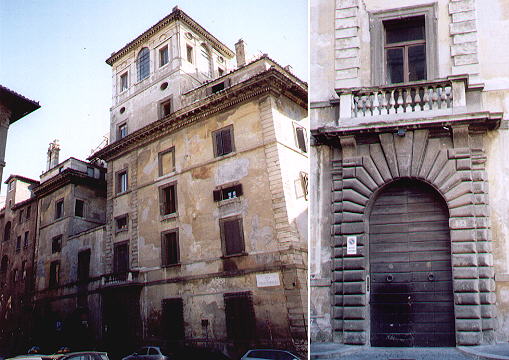|
TIMEO HOMINEM UNIUS LIBRI (St. Thomas Aquinas) (I fear the man who trusts one book only)   In plate 63: Palazzo Colonna Palazzo Muti Papazzurri
Palazzo Muti Papazzurri, located in nearby Piazza della Pilotta, was designed by Mattia de' Rossi in 1660, most likely on the occasion of the marriage between Pompeo Muti Papazzurri and Maria Isabella Massimo. Unfortunately the light and elegant building designed
by this scholar of Bernini was largely modified in 1909 and even the frames of the windows were replaced by very dull ones. The print is a 1699 work by Alessandro Specchi,
an architect himself.
This large late Renaissance building was most likely designed by Bartolomeo Ammannati, a
Florentine sculptor and architect who often worked in Rome,
employed by popes and families who came from Tuscany. It is one of the very few historical palaces which has not been repainted in recent years
and because of its current poor state it does not attract a lot of attention, even though it has one of the first and most
elegant Roman loggias.
In 1760 a certain Nicola di Maddalena levantino (according to the parish records) opened a coffee-shop at the end of Via dei Condotti which
soon became popular among the many foreigners living in the area. Most likely Nicola came from one of the Greek islands belonging to Venice and this
explains the name of his shop. He had to face the competition of Caffè degli Inglesi (now lost) which opened in that same year in Piazza di Spagna. Some rooms of Caffè Greco are decorated with paintings showing views of Rome.
Abito alla Balduina "I live in Balduina" is not only an indication of where you live, but a sort of status symbol which says that you are very wealthy (or that you pretend to be). It is very expensive to buy or rent a flat in this modern quarter of Rome, built on the rear part of Monte Mario on the site of some old villas, chiefly of Villa Massimo. The pines which here and there embellish the most expensive houses belong to the old villa. Its main building still exists at No 296 of Via della Balduina, behind a modern church. The two wings have lost their late XVIIth century decoration, but the central part retains it. From this point the Massimo enjoyed a great (although remote) view over Rome. In plate 137: S. Maria in Vallicella Palazzo Capponi Stampa
In his guide of Rome, Vasi mentions tre magnifici palazzi (three magnificent palaces) in Piazza dell'Orologio. The most famous one was Palazzo di Santo Spirito, designed by Borromini as headquarters for
Banco di S. Spirito, the papal bank. Eventually the offices of the bank were located in another palace by the same name and the palace built by Borromini
was bought by Cardinal Spada. Unfortunately in the XIXth century it was almost totally modified and only the courtyard retains some traces of the old building.
In the XVIIIth century the Del Cinque family built a very decorated "apartment block" near Piazza di
Montecitorio, but the origin of the family can be traced in this simpler Renaissance house in Trastevere. The madonnella shown above is in the nearby alley by the same name.
The small palace shown by Vasi on the left side of the print has a very interesting
courtyard where an open staircase leads to the various apartments. It is a design very unusual in Rome,
but largely utilized in northern Italy, especially for buildings with many small apartments. Go to my Home Page |
All images © 2005 by Roberto Piperno. Write to romapip@quipo.it (alternative e-mail address at romeartlover@katamail.com)






